Explore Seoul - South Korea Travel, Asia
Seoul, officially known as Seoul Special City, is the capital and largest city of South Korea. It is located on the Han River in the northwestern part of the country and is the cultural, economic, and political center of South Korea. Seamlessly blending ancient traditions with cutting-edge innovation, though, Seoul has a rich history dating back to 18 BC when it was founded by the people of Baekje, one of the Three Kingdoms of Korea. This megacity buzzes with energy 24/7, its streets alive with the hum of commerce, the chatter of street markets, and the gentle chimes of palace bells. Travelers flock to Seoul for its intoxicating mix of ultramodern skyscrapers and serene Buddhist temples, world-class shopping districts and tranquil mountain trails.
Population: Approximately 10 million residents as of 2024
Economy: Seoul is South Korea's economic powerhouse, hosting key industries like technology, entertainment, and finance. The city is home to major corporations and a thriving startup ecosystem, significantly contributing to the national GDP. As a global tech hub and the heart of the Korean Wave, Seoul attracts millions of tourists annually, offering a dynamic mix of traditional and modern attractions. With an efficient transport system and a focus on sustainable tourism, Seoul is a prime destination for travelers looking to experience both rich history and cutting-edge innovation.
Landmarks: Gyeongbokgung Palace, N Seoul Tower, Deoksugung Palace, Changdeokgung Palace, Jongmyo Shrine, Bongeunsa Temple, Namsan, Cheongwadae (Blue House)
South Korea
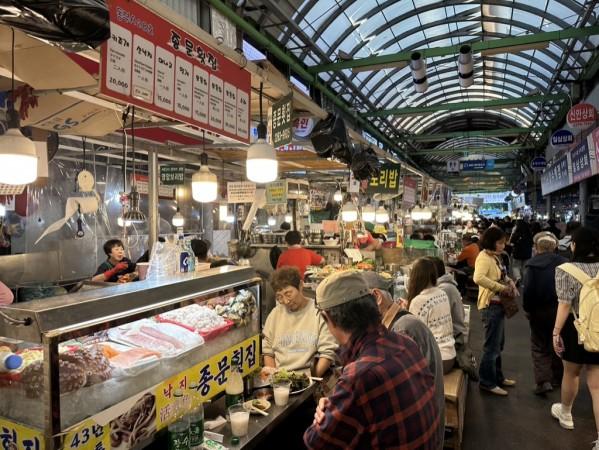
Overview of Seoul
History & Culture Influence
Seoul's origins date back to 18 B.C. when it was founded as the city of Wiryeseong by the Baekje Kingdom. Over the centuries, it became a vital political and cultural center, particularly during the Joseon Dynasty (1392-1910), which established Seoul as its capital. This era saw the construction of many iconic structures, including palaces, temples, and fortresses, that reflect the architectural styles and philosophies of the time. This strategic location between China and Japan made it a vital hub for trade and cultural exchange. The city's prominence grew during the Joseon Dynasty (1392-1910), which solidified Seoul's status as the capital of Korea. The dynasty was marked by significant advancements in arts, science, and governance, laying the foundation for modern Korean culture.
Interaction with The Locals
Interacting with locals in Seoul, visitors can expect a warm and welcoming atmosphere, shaped by the city’s rich cultural heritage and diverse population. Seoul is a bustling metropolis with a population of approximately 10 million, making it one of the largest cities in the world. The city is a melting pot of cultures, primarily consisting of ethnic Koreans, but it also hosts a growing number of expatriates and foreign residents from various backgrounds.

Bukchon Hanok Village - © gather
Top Attractions in Seoul
Seoul, the vibrant capital of South Korea, is home to top attractions such as Gyeongbokgung Palace, where visitors can experience the grandeur of Korean royal history, and N Seoul Tower, offering panoramic views of the city from its iconic observation deck. The bustling shopping district of Myeongdong and the traditional streets of Bukchon Hanok Village provide a perfect blend of modern and historic experiences for travelers.
Gyeongbokgung Palace
Location: 161 Sajik-ro, Jongno-gu, Seoul
Gyeongbokgung Palace, also known as the Northern Palace, is the largest of the Five Grand Palaces built by the Joseon dynasty. Constructed in 1395, it showcases stunning traditional Korean architecture and offers a glimpse into the grandeur of the Joseon era. Visitors can explore the palace grounds, including the iconic Gwanghwamun Gate, and witness the changing of the royal guard ceremony.
Namsan Park and N Seoul Tower
Location: 105 Namsangongwon-gil, Yongsan-gu, Seoul, South Korea
Namsan Park is a popular recreational area in the heart of Seoul, offering hiking trails and panoramic views of the city. At the top of Namsan Mountain stands the N Seoul Tower, a 236-meter-tall communication and observation tower. Visitors can ride a cable car to the tower's observation decks for breathtaking vistas or enjoy the park's natural beauty and hiking paths.
Bukchon Hanok Village
Location: 37, Gyedong-gil, Jongno-gu, Seoul
Bukchon Hanok Village is a well-preserved traditional residential area featuring hundreds of hanok houses dating back to the Joseon dynasty. Visitors can stroll through the charming alleyways, admire the unique architecture, and gain insights into the daily life of the past. Many hanok houses have been converted into cultural centers, tea houses, and boutique hotels, allowing visitors to immerse themselves in the traditional atmosphere.
Cheonggyecheon Stream
Location: Downtown Seoul, South Korea
Cheonggyecheon Stream is a 10.84-kilometer-long modern urban stream that runs through downtown Seoul. Restored from a covered overpass, the stream offers a peaceful respite from the bustling city. Visitors can enjoy a leisurely stroll along the stream, admiring the public art installations and bridges while surrounded by lush greenery.
Changdeokgung Palace and Huwon Secret Garden
Location: 99, Yulgok-ro, Jongno-gu, Seoul, South Korea
Changdeokgung Palace is a UNESCO World Heritage site and one of the Five Grand Palaces of the Joseon dynasty. The palace complex features stunning architecture and the Huwon Secret Garden, a well-preserved ecological garden that was once reserved for the royal family. Visitors can explore the palace grounds and join a guided tour of the secret garden to appreciate its natural beauty and historical significance.
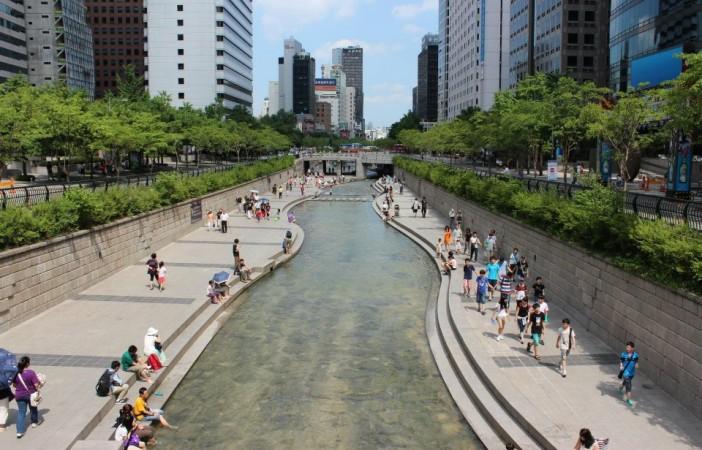
Cheonggyecheon, Seoul - © Grayswoodsurrey
Must-Try Dishes in Seoul
From flavorful mix of rice, vegetables, meat, fried egg to thick slices of grilled pork belly enjoyed with a variety of dipping sauces and side dishes. These are the street food that captures the essence of Seoul's vibrant culinary scene.
Bulgogi
Bulgogi is a classic Korean dish featuring thinly sliced, marinated beef that is grilled at the table. The meat is typically marinated in a sauce made from soy sauce, sugar, garlic, and sesame oil, which gives it a sweet and savory flavor. Bulgogi has been enjoyed since the Goguryeo era in the 37 BC–935 AD period, when it was considered a royal dish. Today, it remains one of the most popular Korean BBQ items and a staple of Seoul's cuisine.
Tteokbokki
Tteokbokki is a spicy, chewy rice cake dish that is a beloved Korean street food. Cylindrical rice cakes are simmered in a gochujang (chili pepper paste) sauce along with fish cakes, scallions, and boiled eggs. The dish originated as a royal court food in the 15th century but evolved into a popular snack in the 1950s. Tteokbokki can be found at street stalls throughout Seoul, especially in areas like Myeongdong and Namdaemun Market.
Kimchi
Kimchi is a staple side dish in Korean cuisine, made from fermented vegetables like napa cabbage or radish. It is seasoned with chili peppers, garlic, ginger, and salted seafood. Kimchi is known for its spicy, tangy, and umami flavors. It is considered a national dish of Korea and is served at nearly every meal. Seoul has a deep connection to kimchi - it is said that a meal without kimchi is almost incomplete. Visitors can learn about the art of kimchi-making at the Seoul Kimchi Academy.
Bibimbap
Bibimbap is a signature Korean dish consisting of warm white rice topped with sautéed and seasoned vegetables, gochujang (chili pepper paste), a fried egg, and often beef. The ingredients are meant to be mixed together thoroughly before eating. Bibimbap is known for its colorful presentation, with each ingredient symbolizing harmony and balance in Korean cuisine. It is a popular choice for its delicious flavors and versatility - vegetarian versions are also available. Bibimbap can be found at many Korean restaurants in Seoul.

Bulgogi - © Milk Street
Weather in Seoul: Best Time to Visit
Seoul experiences a continental climate characterized by four distinct seasons: cold, dry winters and hot, humid summers.
Average Temperatures
- Winter in Seoul: January is the coldest month with average temperatures around -2.1°C (28°F). Temperatures can drop as low as -6.2°C (21°F) at night.
- Spring in Seoul: March averages around 6.1°C (43°F), increasing to 18.3°C (64°F) in May. Spring is generally mild and pleasant.
- Summer in Seoul: July is the hottest month with an average temperature of 25.5°C (77.8°F), with highs reaching up to 35°C (95°F). August also remains warm, averaging around 26.3°C (79.3°F).
- Autumn in Seoul: September averages 21.6°C (71°F), dropping to 7.2°C (45°F) by November. October is particularly pleasant with mild temperatures.
Rainfall
- Annual Average: Seoul receives about 1,420 mm (55.9 inches) of precipitation annually.
- Wettest Months: July is the wettest month, averaging around 415 mm (16.3 inches) of rain. August also sees significant rainfall, averaging about 350 mm (13.8 inches).
- Driest Months: January is the driest month with approximately 15 mm (0.6 inches) of precipitation.
Best Time to Travel
- Spring (April to June): This is considered one of the best times to visit due to mild temperatures and blooming cherry blossoms.
- Autumn (September to November): Another ideal time for travel, featuring comfortable weather and beautiful fall foliage.
- Summer (July to August): While summer offers vibrant festivals, it is also hot and humid with heavy rainfall, which may not be suitable for all travelers.
- Winter (December to February): Cold temperatures and occasional snowfall can be appealing for those interested in winter sports or experiencing a traditional Korean winter.
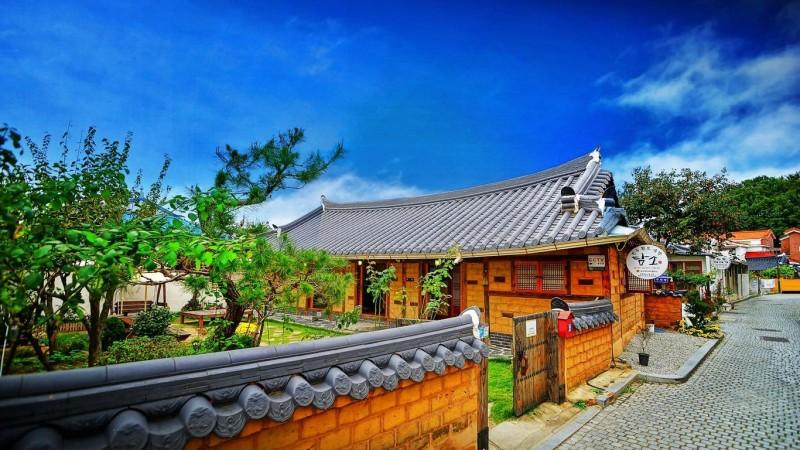
Jeonju Hanok Maeul Damso - © Momondo
Cultural Etiquette in Seoul
- Greetings and Introductions: In Korean culture, a slight bow is the customary greeting, with a deeper bow showing greater respect. When shaking hands, especially with elders or superiors, use both hands or your right hand supported by your left. Expect personal questions, as they reflect polite interest in your life.
- Dining Etiquette: Wait to be seated, allowing elders and those of higher status to sit first. The eldest are served first and begin eating before everyone else. Avoid pointing chopsticks at others, standing them upright in rice, or eating with your fingers. Pour drinks for others before serving yourself, using both hands.
- Gift Giving: Gifts are presented with both hands and received with a slight bow. Avoid giving white flowers, as they are associated with funerals.
- Manners and Customs: Remove your shoes when entering a home or some traditional restaurants. Avoid excessive body contact, as personal space is valued in Korean culture. Punctuality is highly respected, so strive to be on time. Modesty and humility are admired traits in Korean society.
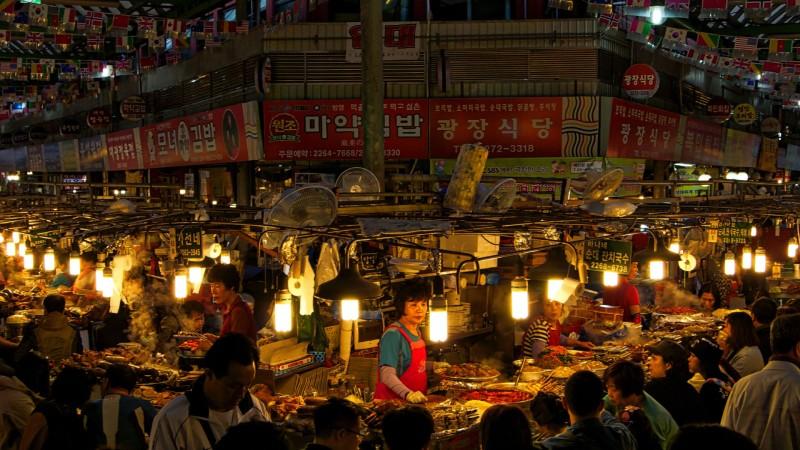
Gwangjang Market - © Chris and Sara
Essential Travel Information
Getting Around Seoul
- Subway System: Seoul's subway system is one of the most extensive and efficient in the world, featuring 9 main lines and several extensions. It operates from 5:30 AM to midnight and serves over 8 million passengers daily. The subway is known for its cleanliness, safety, and affordability, with fares starting at ₩1,250. Stations are equipped with multilingual signage, making it accessible for international travelers.
- Buses: The bus system in Seoul is also well-developed, with four types of buses categorized by color:
- Blue Buses: Connect suburban areas to the city center.
- Green Buses: Operate within districts, linking subway stations and neighborhoods.
- Red Buses: Express buses that connect the city center to the outskirts.
- Yellow Buses: Circulate within specific districts, ideal for tourists.
Buses are a cost-effective way to navigate the city, with fares typically starting at ₩1,200.
- Taxis: Seoul's taxis are plentiful and can be easily hailed on the street or booked via apps. Regular taxis are affordable, while deluxe taxis offer a more comfortable ride. The fare starts at ₩3,800, with additional charges based on distance and time. For convenience, it’s advisable to have your destination written in Korean.
ATM and Banking Services
- Availability: ATMs are widely available at airports, train stations, convenience stores, and bank branches.
- Languages: Most ATMs offer services in Korean and English.
- International Cards: Many ATMs accept international cards, but it's advisable to check for compatibility.
Where to Stay in Seoul
- Hotels: Seoul offers a wide range of hotels, from luxury international chains to budget-friendly options. Popular areas for tourists include Myeongdong, Gangnam, and Insadong.
- Guesthouses and Hostels: For budget travelers, guesthouses and hostels provide affordable accommodation with a social atmosphere. These are often located in central areas, making it easy to explore the city.
- Serviced Apartments: Serviced apartments are ideal for longer stays, offering more space and amenities like kitchens. They are available in various parts of the city, catering to both business travelers and families.
- Traditional Hanok Stays: For a unique experience, consider staying in a traditional hanok house. These accommodations offer a glimpse into Korean culture and history, with locations in areas like Bukchon Hanok Village.
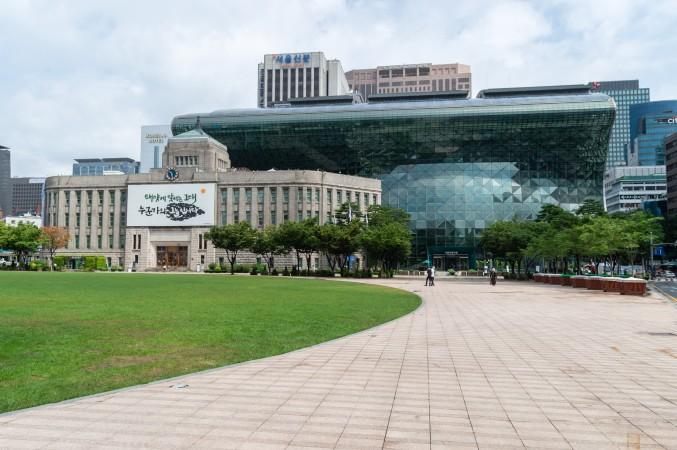
Seoul City Hall - © Tristan Surtel
Shopping in Seoul
Insadong
Insadong is known for its traditional Korean arts, crafts, and antiques. Wander through the narrow alleyways lined with galleries, craft shops, and teahouses. Some top spots include:
- Ssamziegil: A modern traditional craft mall with unique handmade crafts and souvenirs on each floor.
- Alive Museum: An interactive art museum with optical illusion exhibits great for photos.
- Jongno Antique Street: Browse antique shops and galleries selling Korean paintings, ceramics, and furniture.
Namdaemun Market
Namdaemun Market is Seoul's largest traditional market, selling everything from clothing and accessories to ginseng and souvenirs. Look for: Korean fans and traditional hats, Hanji (traditional Korean paper) products, Ginseng and Korean red ginseng candy
Dongdaemun Design Plaza (DDP)
The futuristic DDP complex houses design shops, galleries, and the Dongdaemun History & Culture Park. Check out:
- Designers' Village: Shops featuring up-and-coming Korean fashion and accessory designers.
- Dongdaemun Design Market: A 24-hour shopping complex with trendy Korean fashion and accessories.
Myeongdong
While known for its cosmetics shops, Myeongdong also has plenty of souvenir options like:
- Myeongdong Kyoja: Famous for kalguksu (knife-cut noodles) and mandu (dumplings).
- Myeongdong Alley Food Street: Stalls selling Korean street food like tteokbokki (spicy rice cakes).
- Myeongdong Cosmetic Shops: Pick up Korean beauty products as souvenirs.
Articles for you

Experience Aboard The RV Indochine II - A Mekong Cruise With Tweet World Travel
The RV Indochine II is a luxury river cruise ship, offering an unforgettable journey through many attractions along the Mekong River. Built in 2017, this upscale vessel combines colonial elegance with modern conveniences to create a comfortable yet stylish environment for its crew and passengers. The ship’s intimate size makes it ideal for those seeking a more personal cruising experience while exploring Vietnam and Cambodia rich culture, scenery, and heritage. Whether you're gazing at the landscape from your private balcony or enjoying authentic local cuisine, RV Indochine II promises an exotic adventure like no other.

Witness Stilt Fishing In Sri Lanka: An Eco-Tourism Experience
Sri Lanka, renowned for its stunning beaches and rich cultural heritage, harbors a unique tradition that has captivated travelers for centuries: stilt fishing. This ancient practice, passed down through generations of coastal communities, blends artistry with necessity, offering a glimpse into a way of life intimately connected to the island's coastal rhythms. Stilt fishing in Sri Lanka isn't merely a means to catch fish; it's a cultural emblem, embodying the resilience and ingenuity of Sri Lanka's fishing communities.

Make Your Trip Stress-Free With The Tweet Trip App
Embark on your next adventure with confidence by downloading the Tweet Trip App, available for both iOS and Android. This essential travel companion allows you to view your detailed itinerary, stay connected with your tour guide and fellow travelers, receive real-time updates, and provide feedback effortlessly. With features like in-app messaging, emergency assistance, and location sharing, the Tweet Trip App ensures you travel smarter, stay connected, and enjoy a seamless, worry-free journey. Get started today and make the most of your travel experience with Tweet World Travel.

Pedal Through Paradise: Unveiling Cambodia's Hidden Gems on Two Wheels
The gentle whir of bicycle wheels mingles with the distant chants of monks as you glide past emerald rice paddies stretching to the horizon. This is Cambodia - a sensory explosion waiting to be experienced on two wheels. At Tweet Tours, we believe there's no better way to immerse yourself in the Kingdom of Wonder than by bicycle.
Cambodia isn't just a destination; it's a living, breathing tapestry of ancient wonders, natural beauty, and vibrant culture. Our carefully crafted cycling tours take you beyond the typical tourist haunts, offering a unique perspective on this captivating country. Ready to clip in and discover the magic of Cambodia? Let's ride!

Trekking in the Himalayas: A Journey Through Nepal's Majestic Peaks
The Himalayas rise from the earth like colossal guardians, their snow-capped peaks piercing the sky in a display of nature's raw power and beauty. Nepal, nestled at the heart of this mountain range, serves as the gateway to some of the most breathtaking trekking experiences on the planet. Here, the air is crisp and thin, filled with the promise of adventure and the whispers of ancient tales.
With Tweet Tours, as you set foot on these hallowed trails, you're not just a traveler - you're a modern-day explorer, following in the footsteps of legendary mountaineers and age-old traders. Each step takes you further into a world where nature reigns supreme and human resilience is tested against the backdrop of some of the world's highest peaks.
From the moment your boots touch the ground in Kathmandu, you'll feel the pull of the mountains. The bustling streets of the capital, with their sensory overload of sights, sounds, and smells, soon give way to serene mountain paths where the only soundtrack is the crunch of gravel underfoot and the distant tinkling of yak bells.

Exploring Mui Ne's Wonders: Unique Attractions & Local Dishes
Nestled along the southeastern coast of Vietnam, Mui Ne emerges as a captivating gem, blending natural wonders with cultural richness. Renowned for its stunning landscapes and unique attractions, Mui Ne beckons travelers seeking both relaxation and adventure in equal measure. Mui Ne's renowned beach dunes, bustling fishing towns, and excellent local food await exploration at every turn.
The allure of Mui Ne lies not only in its pristine beaches and crystal-clear waters but also in its diverse range of activities catering to every traveler's whims. Whether you're drawn to thrilling water sports like kitesurfing and windsurfing on its dynamic shores or seeking tranquility amidst the picturesque Fairy Stream, Mui Ne promises an unforgettable journey filled with discovery.
